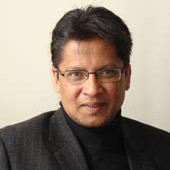India's High-Tech in the 5th Century (Part II)
How have India’s early scientists impacted Western thought?
April 24, 2009
As India seeks to recapture its immense historical presence, some argue that the country's global software industry is fed by what French philosopher Henri Bergson called an “élan vital” (vital spirit) — as the birthplace of mathematics and several other sciences, including medicine.
Few are indeed aware of the sheer magnitude of breakthroughs made in that country, a thousand years before Europe.
American software guru Capers Jones is one exception. He describes India's ancient Nalanda University (founded in the 5th century BC) as "the largest in the world for more than 1,200 years," with "a scientific curriculum that would not be far behind contemporary universities."
It is now generally accepted that “Arabic numerals” are really “Indian” and, as explained in depth by Denis Guedj of the University of Paris, India invented the "wonderful system" of the zero and positional notation, as well as the decimal system.
Ancient India made massive advances in areas such as advanced number theory, negative numbers, computational mathematics, algebra and trigonometry. These not only laid the foundations for modern science and technology, but were in many cases simply “rediscovered” in Europe.
It does not require much effort to recognize that the Industrial Revolution, let alone the New Economy, may not have gotten very far with Roman numerals.
British researchers at the University of St. Andrews in Scotland have studied this subject at considerable length.
"It is without doubt," they state, "that mathematics today owes a huge debt to the outstanding contributions made by Indian mathematicians over many hundreds of years. What is quite surprising is that there has been a reluctance to recognize this…
"Quite a few results of Indian mathematicians have been rediscovered by Europeans. For instance, the development of number theory, the theory of indeterminates, infinite series expressions for sine, cosine and tangent, computational mathematics, etc…."
They provide other “rediscovered” examples: "a formula for the ecliptic, the Newton-Gauss interpolation formula, the formula for the sum of an infinite series, Lhuilier's formula for the circumradius of a cyclic quadrilateral."
Two of the St. Andrews' research papers concern the 5th century Indian mathematician Aryabhata, and astronomer Brahmagupta, who lived two centuries later. Aryabhata calculated pi to the 8th decimal place (3.14159265) and valued the length of the year at 365 days 6 hours 12 minutes 30 seconds — remarkably close to the current figure of 365 days 5 hours 48 minutes and 46.5 seconds.
More strikingly, over 500 years before Copernicus and Galileo, Aryabhata also "believed that the apparent rotation of the heavens was due to the axial rotation of the Earth," that "the Moon and planets shine by reflected sunlight, that the orbits of the planets are ellipses" and correctly explained "the causes of eclipses of the Sun and the Moon."
Brahmagupta, who headed an astronomical observatory at Ujjain in the 7th century, contributed the following: "mean longitudes of the planets, true longitudes of the planets, the three problems of diurnal rotation, lunar eclipses, solar eclipses, risings and settings, the moon's crescent" and the conjunctions of planets.
He extended arithmetic to negative numbers and the zero, developed an algorithm for computing square roots— which is shown to be "equivalent to the Newton-Raphson iterative formula" — and solved quadratic indeterminate equations.
In the specific field of computer programming, such arguments become truly striking. According to another paper from St. Andrews, Panini — an Indian grammarian who lived in the 5th century BC and compiled 4,000 rules and metarules of Sanskrit — "should be thought of as the forerunner of the modern formal language theory used to specify computer languages."
Though the Backus Normal Form was discovered independently by John Backus in 1959, Panini's notation, say the British researchers, "is equivalent in its power to that of Backus and has many similar properties."
"It is remarkable to think that concepts which are fundamental to today's theoretical computer science should have their origin with an Indian genius around 2,500 years ago," the paper concludes.
These remarkable achievements are of little utilitarian value today, having long been eclipsed by subsequent work. But they provide a strong source of confidence to a rebounding India.
For foreigners in particular, an important issue to take note of is India's continuity as a culture, grasped by some viewers of Vedic rites at the holy city of Banaras (Varanasi).
American writer Mark Twain described the city as being "older than history, older than tradition, older even than legend, and looks twice as old as all of them put together." Unlike ancient Greece and Egypt, Babylon or the Incas and Mayas, India's customs, cultural practices and expectations have changed little over the past five or six thousand years.
While past glories are one thing, India is increasingly aware that its caste-fragmented innards are among the reasons for its historical eclipse. Economically and militarily, but above all socially and politically, re-emerging India is clearly seeking to address such weaknesses.
In turn, the country's unique development pathways can reveal much about its formidable nature as a global competitor — and how other nations can learn from it, and effectively respond to it.
Takeaways
Ancient India's massive advances not only laid the foundations for modern science and technology, but were in many cases simply "rediscovered" in Europe.
American writer Mark Twain described Varanasi as being "older than history, older than tradition, older even than legend, and looks twice as old as all of them put together."
Over 500 years before Copernicus and Galileo, Aryabhata "believed that the apparent rotation of the heavens was due to the axial rotation of the Earth."
